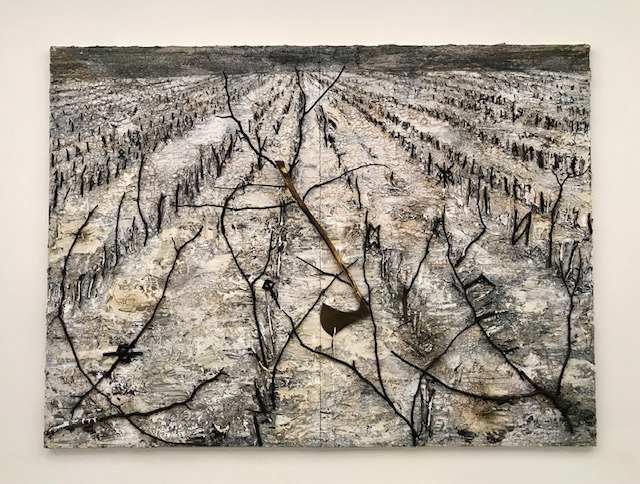Review #Two - Der Gordische Knoten - Kiefer
- Julie Ellis

- May 14, 2020
- 3 min read
Der Gordische Knoten
2018
Oil, emulsion, acrylic, shellac, wood and metal on canvas
110 1/4 x 149 5/8 in. (280 x 380 cm)
(White Cube Gallery, 2020)
Images: Julie Ellis
Anselm Kiefer – B: 8 March 1945
The exhibition Superstrings, Runes, The Norns, Gordian Knot reflects Keifers interest in mythology, astronomy and history. Kiefer makes visual the idea that, ‘everything is connected: the missing letters, string theory, the Norns, the Gordian knot. (cube, 2019) The exhibition is broken into four areas, The painting ‘ Der Gordische Knoten’ It is situated in gallery space two which presents large scale works obscured vast landscape-like spaces referencing the Gordian knot, each with a central vanishing point having in common a protruding axe head at the centre of the canvas.
‘Der Gordische Knoten’is a large mixed media painting consisting of Oil, emulsion, acrylic, shellac, wood and metal on two connected canvas’s measuring almost three metres high by four metres wide. The scale is dominating and comfortably fills the empty white gallery space. The painting is landscape both in orientation and representational terms. The perpectival lines made up of vertical scorched branches and sticks draw the eye to a centre point over the horizon towards the charcoal rendered sky. Protruding from the centre of the canvas is an axe; the handle is a roughly cut branch with twigs and scorched leaves still present. The scorched blackness of the axe is set against a colour palette which is limited to natural and tonal dirty whites and greys using heavily applied pigment. The medium spills over the canvas where finger marks and charcoal can be seen on the raw canvas edges. There was a scorched smell of wood, ash and dust present in the space which added atmosphere and a closeness to the work. Heavily layered paint, cracking in places with hand or perhaps brush marks gouging through the work. All visible at close contact and yet stepping back it become something else, an overbearing visual landscape to enter.
‘Der Gordische Knoten’ clearly represents the landscape however Keifer is referencing many ideas within this work, there is not one singular narrative but many overlapping ideas around folklore, mythology and scientific fact and the artists cultural roots. The imagery seems universal and accessible as it has an aesthetic quality tied up in our deep rooted understanding of traditional landscape which is to do with colour, composition and scale leaving the viewer to take something from the experience weather they choose to acknowledge the symbolic component of the works or not. The component in this case being the axe which represents the impenetrable knot referred to in the legend associated with Alexander the great (see footnote) symbolic of unsolvable problems, mathematics, science and infinity present in Keifers work.
I experienced the exhibition as whole, having seen Keifer’s work before I couldn’t avoid a feeling of continuity from previous work, commons threads being the sense of Scale and magnitude to the work and his use of materials. To see Keifer’s work in the gallery space surpasses the images one can see through other mediums not only in terms of scale but the texture, smell, and nature of the materials. There is a feeling of experience and history linked to the chosen mediums used, objects from nature, the ash, the branches and their associated age. The process and hand of the artist is visible through the movement and mark making of their application and my understanding of Kiefers spiritual approach to his practice.
Links for essay???
· Alchemy: (Elkins) To do with process, and the overlapping of different notions and ideas combined with intuitive methods of making.
· There were some references to music in the panel discussion associated with the gallery. Kiefer talks about the universal language of music and art for the viewer. This could link to Coussens and Maja Solveg Kjelstrup Ratkje
· Kiefer talks about duration and the never ending piece. ? Bergson,
· Intuition being used in terms of referencing subject matter which is not necessarily fully understood but ‘feels’ relevant or resonates with the artists. I.e. maths, science, history.
Footnote
The title, ‘Der Gordische Knoten’ (Gordian Knot) is taken from a legend told within the story of Alexander the Great. The legend describes an impenetrable knot which grants the person who can untie it the power to rule. Over the years the term Gordian knot is more commonly used when describing an unsolvable problem. ‘The saying “cutting the Gordian knot” is now commonly used to describe a creative or decisive solution to a seemingly insurmountable problem’. (Andrews, 2016). The axe in the centre of the painting represents the cutting of the Gordian knot.
References
Cube, W. (2019). White Cube - Exhibitions - Superstrings, Runes, The Norns, Gordian Knot. [online] Whitecube.com. Available at: https://whitecube.com/exhibitions/exhibition/anselm_kiefer_bermondsey_2019 [Accessed 18 Nov. 2019].
Andrews, E., 2016. What Was The Gordian Knot?. [online] HISTORY. Available at: <https://www.history.com/news/what-was-the-gordian-knot> [Accessed 12 May 2020].
White Cube Gallery, 2020. Anselm Kiefer Panel Discussion | White Cube. [video] Available at: <https://www.youtube.com/watch?v=XWGvH6-3Cp4&t=2138s> [Accessed 12 May 2020].










Comments